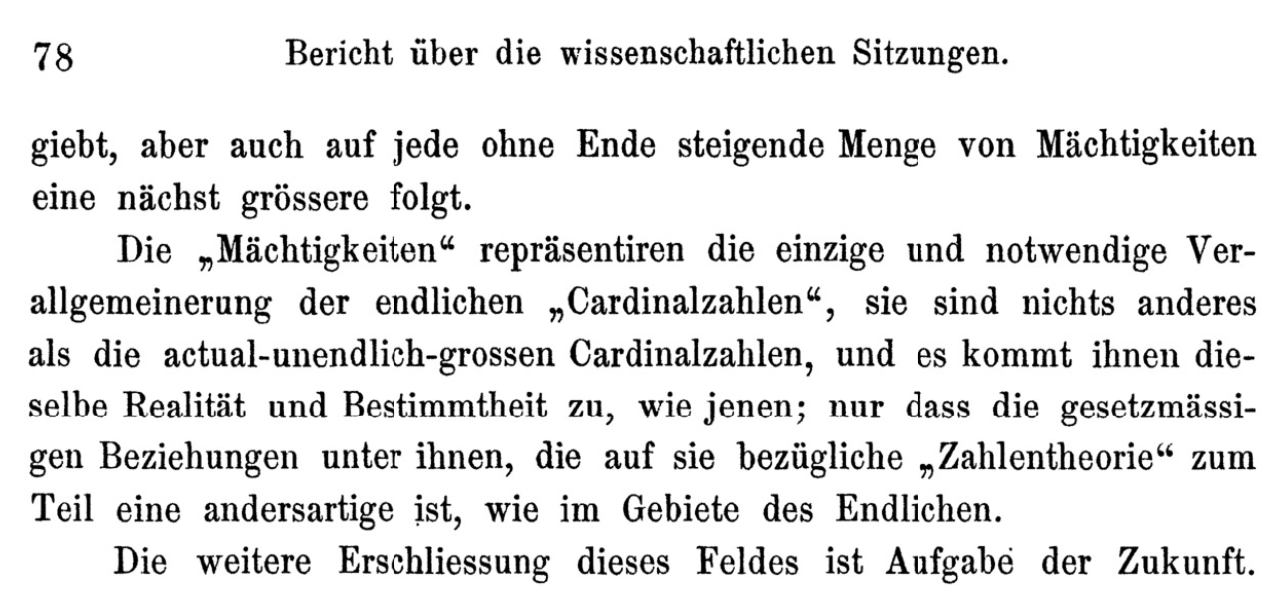In Cantor's set theory, is there any difference between the terms Mächtigkeit and Kardinalität ?
-
2$\begingroup$ (warning: bad German ahead) Lawvere certainly seems to think that the difference between Menge and Kardinale is one that has been lost ncatlab.org/nlab/show/… . I'm not completely familiar with Mächtigkeit and Kardinalität, but I guess the former would be translated 'potency', so that sets (Mengen?) are equipollent when there is an isomorphism between them. The Kardinale associated to a Menge is a different sort of object, and so I guess that's why one could talk of the Kardinalität as something distinct $\endgroup$– David Roberts ♦Aug 16, 2018 at 5:02
-
1$\begingroup$ Do you mean "to Cantor", when you say "in Cantor's set theory"? Or in the broader sense of set theory as it generally stood at its beginning? $\endgroup$– David Roberts ♦Aug 16, 2018 at 5:55
-
4$\begingroup$ Looking at your recent questions, it might be worth mentioning that there is also a separate site for History of Science and Mathematics. At least some of the top ho.history-overview answerers on MO have an account also on that site; for example, Carlo Beenakker, Francois Ziegler or Alexandre Eremenko. $\endgroup$– Martin SleziakAug 16, 2018 at 7:17
-
1$\begingroup$ I'm voting to close this question just because it would be suited for HSM (not because I think it is a bad question per se) $\endgroup$– Yemon ChoiAug 16, 2018 at 23:14
3 Answers
Here is how Cantor introduced "Mächtigkeiten" in Ueber eine elementare Frage der Mannigfaltigketislehre (1890):

The "Mächtigkeiten" represent the unique and necessary generalisation of the finite "Cardinal numbers", they are nothing other than infinitely large Cardinal numbers, and they share the same reality and definiteness.
So it seems that, at least initially, Cantor did not speak of "Kardinalität", which was linked to the existing term of "cardinal numbers", a term from the 16th century meaning "principal numbers". He introduced a new term "Mächtigkeiten" for infinitely large cardinal numbers. The dictionary I consulted lists 1935 as the first use of the term "cardinality". Because "Mächtigkeiten" is not easily transferred to the English language, the shift to "Kardinalität" and "cardinality" seems a natural one.
-
4$\begingroup$ I recall having seen the word "power" used for the size of infinite sets in an older text, but I can't recall where. $\endgroup$– David Roberts ♦Aug 16, 2018 at 6:54
-
3$\begingroup$ The natural cognate of "Mächtigkeit" in English is "mightiness", though it seems to have never been used as a translation, "power" being used instead, as pointed out by David Roberts. An example of an old book where it is used is: books.google.dk/… The phrase "power of the continuum" also seems to have lasted a bit longer than "power" as a general term for cardinality. $\endgroup$ Aug 16, 2018 at 12:21
-
$\begingroup$ There is also "puissance" in French, which can often be seen in old articles by Kuratowski or Sierpinski. $\endgroup$ Aug 16, 2018 at 12:25
-
$\begingroup$ Yes, "power" is sen in old writings in English. The power of the real line is $2^{\aleph_0}$. $\endgroup$ Aug 16, 2018 at 12:42
-
3$\begingroup$ The one place (as far as I know) where "power" is still so common in English that "cardinality" would sound strange is the model-theoretic notion of "categoricity in power". $\endgroup$ Aug 16, 2018 at 12:48
Here is Cantor's Beiträge zur Begründung der transfiniten Mengenlehre (Erster Artikel). Read the bottom four lines on the first page: ",Mächtigkeit' oder ,Cardinalzahl' von $M$ nennen wir $\ldots$". That looks a lot like Cantor intended the two to be names for the same concept. The two lines above that reinforce that idea.
The two terms "Mächtigkeit" and "Kardinalität" do indeed mean the same in Cantor's set theory; also today, for instance in lectures in German and Swiss universities, the terms are used as synonyms for the same concept.
-
3$\begingroup$ I would feel more confident in your answer if there was a direct quote from Cantor supporting it. The oldest reference on that Wikipedia page is a 1928 set theory text, by which time axiomatic set theory had undergone all kinds of conceptual developments (Zermelo, Skolem, Fraekel, von Neumann etc). $\endgroup$– David Roberts ♦Aug 16, 2018 at 5:53
